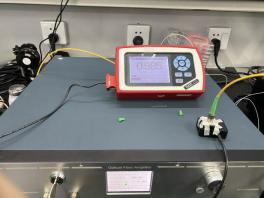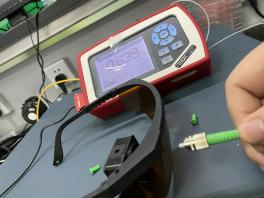- Cart
- |
- Personal Center
- |

Laser protective goggles 10600nm visible light transmittance 60%
Laser safety goggles are a kind of efficient and safe goggles made of polymer materials and light absorbing materials. Its optical safety performance fully meets the European standard EN207A1: 2002. Laser safety goggles are comfortable, beautiful, safe and reliable to wear. They adopt the absorption principle: they are not selective for the incident angle of the light source and can fully protect lasers and strong light in specific bands.
Product features:Typical laser wavelength: 980&1064&1320 nm、 light transmittance: 40%、 O.D optical density: 800-1700nm O.D 4+900-1100nm O.D 5+、 L-Rating(EU standard): 800-1400nm DIR LB4,1400-1700nm DI LB3、 SEM-EP laser protective goggles、 Protective range: 800-1700nm、 Applicable laser wavelength: 808nm, 980nm,1064nm,1320nm,1470nm etc
Part Number:--
Application area:Semiconductor laser debugging and ND:YAG laser protection、 We now have the following types of laser protective goggles for you to choose from
Add to Cart Consult Favorite
Advantages and disadvantages of absorption and reflection laser protective goggles:
Reflective laser protective goggles are coated with multiple layers of reflective medium on the surface of the base optical glass.
Advantages:
1. Simple process;
2. High visible light transmittance;
3. High attenuation rate;
4. Fast light reaction time <10-9 seconds;
Disadvantages:
1. It has serious selectivity for light sources. The incident light source must be facing the protective mirror surface (the normal direction of the incident light mirror surface) to maximize its protective effect and vice versa;
2. The reflective medium layer is easy to fall off and it is not easy to observe with the naked eye after falling off. This is also the most dangerous. The reflective medium layer in China generally falls off in about a year. The higher the light attenuation rate, the thicker the dielectric layer, and the easier it is to fall off.
Absorption protective goggles add special wavelength absorbers to the base material PMMA or P.C.
Advantages:
1. No selectivity for light sources, can safely protect various diffuse reflected lights;
2. High attenuation rate;
3. The surface is not afraid of wear and tear, even if there are scratches, it does not affect the safety protection of light;
4. Fast light reaction <10-9 seconds;
Disadvantages: Low visible light transmittance.
We now have the following types of laser protective goggles for you to choose from
Protective goggles PN# | protective wavelength range(nm) | For typical laser | Typical laser wavelength(nm) | Optical density | Visible light transmittance(%) |
SEM-EP-1 | 200-540 | Frequency-doubled Nd:YAG laser | 532 | 4+ | 50 |
Ion laser | 514 | 4+ | |||
SEM-EP-2 | 600-700 | He-Ne laser | 632.8 | 4+ | 30 |
SEM-EP-3 | 800-1100 | Nd:YAG laser | 1064 | 4+ | 40 |
SEM-EP-4 | 200-540 | Ion laser | 514 | 40 | |
Frequency-doubled Nd:YAG laser | 532 | 4+ | |||
Semiconductor laser | 808、810、904、980 | 4+ | |||
YAG laser | 1064 | ||||
SEM-EP-5 | 10600 | CO2 laser | 10600 | 4+ | 60 |
SEM-EP-8 | 800-1700 | Semiconductor laser | 1510、1530、1610、1550、1350 | 4+ | 40 |
SEM-EP-8 transmission power test (taking 1578nm semiconductor DFB 1W laser test as an example)
 |  |
Power before laser protective goggles | Power after laser protective goggles |
Laser standard and classifications
US laser safety standard ANSI Z136.1
ANSI Z136.1 standard: measured by optical density (OD). The logical relationship between optical density OD and transmittance T: D=-log10 T.
European laser safety standard EN207/EN208
EN207/EN208 standard: consider optical density OD, and also consider damage threshold (power/energy density changes over time).
According to the US laser safety standard ANSI Z136.1 and the European laser safety standard EN207/EN208, lasers can be classified according to the following standards.
Class | Definition | Suggestion |
1 | Non-hazardous | Laser protective goggles are not required |
1M | Visible laser (400-700nm) safe for goggles, without optical magnification | Laser protective goggles are not required |
2 | Visible laser (400-700nm) safe for blinking within 0.25 seconds | Laser protective goggles are not required |
2M | Visible laser (400-700nm) safe for blinking within 0.25 seconds with optical magnification | Laser protective goggles are recommended |
3R | It may be unsafe to look directly at the laser, the maximum permissible exposure (MPE) is 5 times that of Class 2 laser in the visible light part and 5 times that of Class 1 laser in the invisible light part | Laser protective goggles are recommended |
3B | It is unsafe to look directly at the laser, and diffuse laser should be avoided as much as possible | Laser protective goggles are recommended |
4 | It is unsafe to look directly at the laser and its diffuse laser | Laser protective goggles must be used |
Optical Density | Transmission% | Attenuation Factor |
0 | 100% | 1 |
1 | 10% | 10 |
2 | 1% | 100 |
3 | 0.1% | 1000 |
4 | 0.01% | 10000 |
5 | 0.001% | 100000 |
6 | 0.0001% | 1000000 |
7 | 0.00001% | 10000000 |
Laser protective goggles selection guide
1. Laser characteristics: output wavelength and power density of the laser.
2. Optical Density (OD): The larger the OD value, the stronger the protection ability of laser protective goggles.
3. Visible Light Transmittance (VLT): When the VLT value is less than 20%, laser protective goggles need to be used in a well-lit environment.
4. Frame: Whether wearing myopia goggles, facial contour.
Ordering Information
PN#: SEM-EP-1 Name: Laser protective goggles Unit price: 1350 yuan/piece Stock quantity: 20 pieces
Description:
Protection wavelength range (nm): 200-540; For typical lasers: ion lasers; frequency-doubled Nd:YAG lasers,
Typical laser wavelengths: 514, 532nm; Optical density: 4+; Visible light transmittance (%) 50
PN#: SEM-EP-2; Name: Laser protective goggles; Unit price: 1450 yuan/piece; Stock quantity: 20 pieces
Description:
Protection wavelength range (nm): 600-700; For typical lasers: He-Ne lasers; Typical laser wavelengths: 632.8nm; Optical density: 4+; Visible light transmittance (%) 30
PN#: SEM-EP-3; Name: Laser protective goggles; Unit price: 1350 yuan/piece; Inventory quantity: 20 pieces
Description:
Protective wavelength range (nm): 800-1100; For typical lasers: Nd:YAG laser; Typical laser wavelength: 1064nm; Optical density: 4+; Visible light transmittance (%) 40
PN#: SEM-EP-4; Name: Laser protective goggles; Unit price: 1750 yuan/piece; Inventory quantity: 20 pieces
Description:
Protective wavelength range (nm): 200-540, 800-1100; For typical laser types and wavelengths: ion laser Light 514nm; frequency-doubled Nd:YAG laser 532nm; semiconductor laser: 808, 810, 904, 980nm; YAG laser
optical: 1064nm; optical density: 4+; visible light transmittance (%) 40
PN#: SEM-EP-5; Name: laser protective goggles; unit price: 1350 yuan/piece; inventory quantity: 20 pieces Description:
Protection wavelength range (nm): 10600; for typical lasers: CO2 lasers; typical laser wavelength: 10600nm; Optical density: 4+; Visible light transmittance (%) 60
PN#: SEM-EP-8; Name: Laser protective goggles; Unit price: 1450 yuan/piece; Stock quantity: 20 pieces
Description:
Protective wavelength range (nm): 800-1700; For typical lasers: semiconductor lasers, fiber lasers; Typical
Laser wavelengths: 1510, 1530, 1610, 1550, 1350nm; Optical density: 4+; Visible light transmittance (%) 40
--
⇪